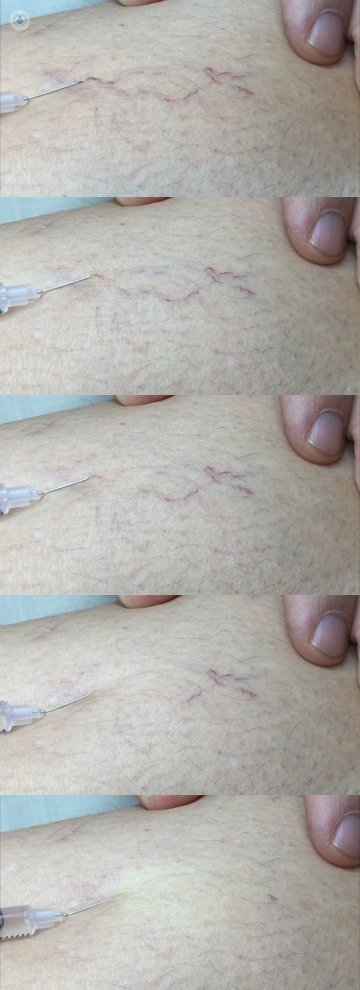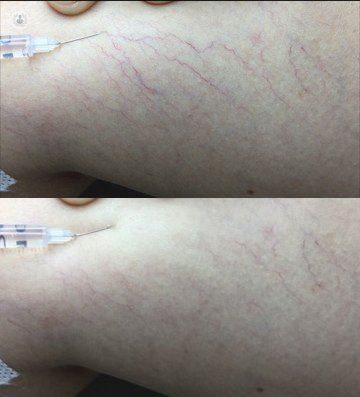How to prevent and eliminate spider veins
Written by:Spider veins, also called telangiectasias or spider veins are dilated blood vessels that belong to the most superficial venous network and found just under the skin. By themselves do not cause a clinical problem, that is, they are not disease, although causing a cosmetic problem that gets worse over time, as they have a tendency to spread.
Why spider veins are formed
They are usually red or purple and are shaped tree, with a main trunk that divides into many branches. They are due to the failure of a micro valve at the level of the main trunk leading to an increase in pressure at the level of capillaries and this makes dilate and hold more blood than normal inside are displayed through the skin.
Spider veins can appear anywhere on the body, such as legs, cheeks or nose, although they are much more common in the legs due to the effect of gravity makes it difficult venous return to the heart compared with other parts of the body.
Risk factors that cause spider veins
In general we talk about genetic factors and hormonal factors, estrogen in women. Anyway there is a widespread belief that only appear in women, but in clinical practice we see that there are a lot of men with spider veins, even if they are partially hidden by the presence of hair.
Other factors may also be the cause of the emergence and spread or worsening telangiectasia:
- Obesity impede venous return by increased pressure in the abdomen and is a risk factor in the onset and development of spiders.
- Postural factors: Being long periods of standing or sitting is also a determining factor overload of the venous system of the lower limbs that have to work against gravity.
- Lack of exercise: Walking a 'pumping' I blood by the so - called "pump plant and twin bomb" that greatly help the venous return occurs. When the person does very little exercise a slowing venous return in the legs which increases the number of spiders, and the appearance of edema or swelling and even the development of varices occurs.
- Taking contraceptives: The contribution of this hormonal treatment also favors the emergence and development of spiders.
- Pregnancy is a period of high risk for the occurrence of these varículas as during the same hormonal overload problem in addition to increased intra - abdominal pressure for fetal growth.
- Other periods of hormonal involvement: as puberty and menopause in women, which can help your new or worsening.
Symptoms of spider veins
As we have said, is not a disease but an aesthetic problem, but part of the aesthetic problem also cause discomfort in the legs that diminish the quality of life. They can produce or join the so - called orthostatic syndrome consisting of a set of symptoms like heaviness, itching, tingling, warmth ... etc.
After removal of these varículas, apart from cosmetic enhancement, the feeling of legs more rested with consequent improvement in the quality of life occurs.
Preventing the appearance of spider veins or telangiectasias
Decreased risk factors, ie, exercising the legs, fight obesity and avoid being long periods of standing or sitting.
Using compression stockings legs, especially during work if it requires standing or sitting. Also use during pregnancy to avoid the appearance of these spider veins and varicose veins.
Treatments for spider veins 
There are two types of treatment for telangiectasia pursuing the same goal: the closure of these spider veins, that is, to stop them passing blood and then the body will take care of them disappear to stop being useful.
Remove spider veins laser
It consists of making different laser shots in the leg veins path thereby achieving a photocoagulation of the same and that the agency remove them later. In taking shots transcutaneously it requires a skin protection is above the leg veins to avoid injury to the same. Typically this is done by precooling the skin to avoid microquemaduras that could leave pigmented. One drawback is that only small areas are treated in each session and requires long process.
Remove spider veins with sclerotherapy
Sclerotherapy is the most common treatment and can treat larger areas of skin in one session, reducing treatment time. Is injected through very fine needles a sclerosing liquid spider veins to create irritation within them that will be closed. Then the body will deal with their elimination and disappearance. This treatment allows larger areas in less time by diffusion of sclerosing within the bunch of spiders in each injection, allowing treat both legs in one session.
You will be required after one or two weeks, review on the same treated area to achieve the total elimination of remaining telangiectasias. The number of review sessions will depend on the number and extent of spiders present each patient.
This treatment is applied in practice without requiring prior anesthesia or medical leave. In fact the patient keeps your personal and work activities immediately. This treatment is very effective if done correctly.




